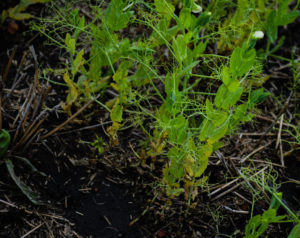Field Pea – Seed or Soil-Borne Diseases
Root Rot Diseases – Seed Rot, Root Rot, Seedling Blights; Rhizoctonia Root Rot, Fusarium Root Rot, and Aphanomyces Root Rot |
|
CAUSED BY |
|
SYMPTOMS |
|
PREVENTION AND CONTROL |
|
IMPACT |
|
RESOURCES |
|
Aphanomyces Root Rot
Rotation impact on reduction of Aphanomyces Root Rot with six year rotation on left versus four year rotation on right. |
|
CAUSED BY |
|
SYMPTOMS |
|
PREVENTION AND CONTROL |
|
IMPACT |
|
RESOURCES |
|
Fusarium Root Rot |
|
CAUSED BY |
|
SYMPTOMS |
|
PREVENTION AND CONTROL |
|
IMPACT |
|
RESOURCES |
|
Pythium Root Rot |
|
CAUSED BY |
|
SYMPTOMS |
|
PREVENTION AND CONTROL |
|
IMPACT |
|
RESOURCES |
|
Rhizoctonia Root Rot |
|
CAUSED BY |
|
SYMPTOMS |
|
PREVENTION AND CONTROL |
|
IMPACT |
|
RESOURCES |
|
Other seed or soil-borne diseases that are less common include Anthracnose, Bacterial Blight, Brown Spot, Cladosporium Blight, Pink Seed, and Septoria Blotch.
Anthracnose |
|
CAUSED BY |
|
SYMPTOMS |
|
PREVENTION AND CONTROL |
|
Bacterial Blight |
|
CAUSED BY |
|
SYMPTOMS |
|
PREVENTION AND CONTROL |
|
Brown Spot
|
|
CAUSED BY |
|
SYMPTOMS |
|
PREVENTION AND CONTROL |
|
Cladosporium Blight |
|
CAUSED BY |
|
SYMPTOMS |
|
PREVENTION AND CONTROL |
|
Pink Seed
|
|
CAUSED BY |
|
SYMPTOMS |
|
PREVENTION AND CONTROL |
|
IMPACT |
|
RESOURCES |
|
Septoria Blotch |
|
CAUSED BY |
|
SYMPTOMS |
|
PREVENTION AND CONTROL |
|
Special thanks to Saskatchewan Pulse Growers and Manitoba Pulse and Soybean Growers.




